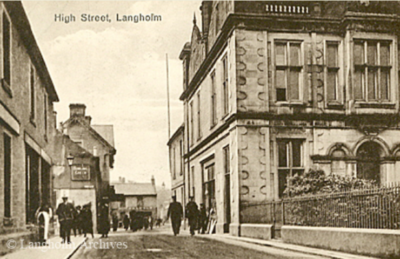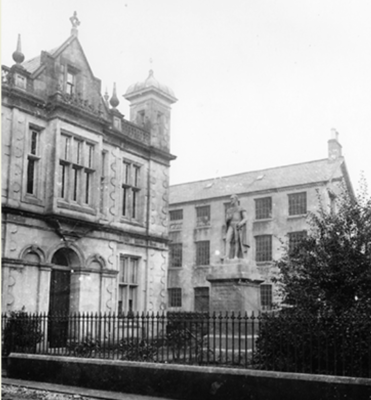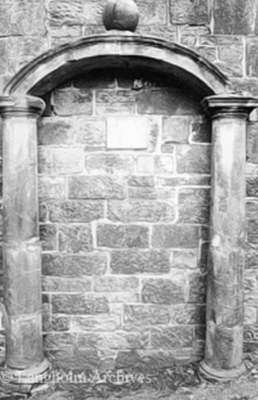Langholm Library was founded in 1800 and purchased books with funds from donations and members’ subscriptions. One of the donors was the engineer Thomas Telford (1757-1834), born in the neighbouring parish of Westerkirk, who gave Westerkirk Parish Library and Langholm Library £1,000 each in his will and an additional £1,700 to Westerkirk from the residue of his estate.
From 1877, the Langholm Library was housed in a large, purpose-built building adjoining the Town Hall. The library was constructed in Jacobean style with funds provided in part by woollen mill manufacturer Alexander Reid (1814-1874). The architect was local resident James Burnet (1826-1898) who also designed many other structures in the area.

Upon the new library building’s opening, the post office and the businesses of Robert Scott (bookseller/stationer/printer) relocated there.
The library had a garden, into which a statue of admiral Sir Pulteney Malcolm (1768-1838) was moved from in front of the Town Hall in 1886.

Also relocated into the garden, in 1908, was the doorway arch of the old King’s Arms Hotel, the predecessor of the Eskdale Temperance Hotel. The arch is said to have been the work of Thomas Telford.

Christopher Grieve (later Hugh MacDiarmid, writer) lived in the building from age seven in 1899, next to the post office. His father was a postman to rural areas and his mother was a caretaker for the library above. He later attributed his access to the library’s books as a key formative influence. He gave his address as ‘Library Buildings’ in 1913 when he joined in a spat in the local paper, triggered by a lecture on local history, but the family had moved by 1915.
The 1915 valuation roll lists three properties owned by Members of Langholm Library (all part of the same building):
- Library buildings and house High Street.
- House High Street: tenant Thomas Wilson, a retired shepherd (latterly at Hillhead, Langholm), perhaps the new library caretaker.
- Shop and post office High Street.